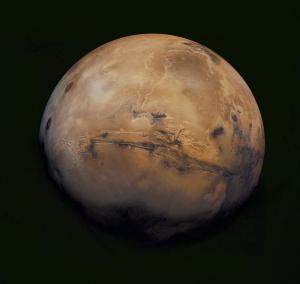Valles Marineris, a canyon system as wide as the United States, slashes across Mars in this global view from Viking 1. The system was discovered in images from Mariner 9, the first craft to orbit any planet other than Earth. It arrived at Mars 50 years ago, during a dust storm that obscured the entire planet. After the dust cleared, it snapped more than 7,000 images, which showed ancient river beds, giant volcanoes, huge fields of sand dunes, and other features never seen before. Valles Marineris was named in Mariner 9's honor. [NASA/JPL]
You are here
Mariner 9
When Mariner 9 entered orbit around Mars 50 years ago today, the view was awful. A dust storm blanketed the entire planet. About all that Mariner’s cameras could see were yellow clouds of dust and a few tall mountains rising above them.
By a couple of months later, though, the dust had settled, and the first spacecraft to orbit any planet other than Earth got busy. By the end of 1972, it had snapped more than 7,000 pictures of the Red Planet. They showed giant volcanoes, polar ice caps, and other wonders. They made Mariner one of the most successful space missions in history.
Earlier missions had simply flown by Mars. They’d seen only a fraction of the planet — relatively boring regions that revealed little about Mars’s true character.
Mariner 9 went far beyond that, however. It photographed almost the entire planet. It found that Mars is a dynamic world with lots to study. It showed us channels that once carried mighty rivers, suggesting that Mars was much more comfortable in the distant past. It saw volcanoes larger than anything on Earth. And it discovered a canyon system that would stretch across the entire United States. Scientists named it Valles Marineris — Mariner’s Valley.
Although it’s been silent for almost half a century, Mariner 9 continues to orbit Mars — but probably not for much longer. Its orbit could decay as early as next year — sending it plunging to the surface of the planet it taught us so much about.
Script by Damond Benningfield
Get Premium Audio
Listen to today's episode of StarDate on the web the same day it airs in high-quality streaming audio without any extra ads or announcements. Choose a $8 one-month pass, or listen every day for a year for just $30.







